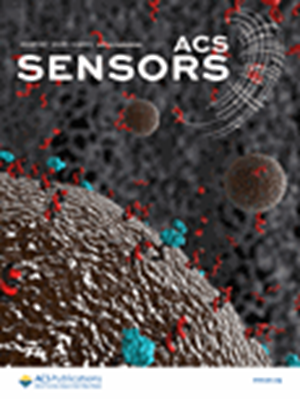High-Performance H2S Sensors to Detect SF6 Leakage
IF 8.2
1区 化学
Q1 CHEMISTRY, ANALYTICAL
引用次数: 0
Abstract
Detecting H2S in oxygen-deficient conditions is vital for identifying leaks in SF6-insulated electrical equipment. Current infrared-based detection methods are expensive and sensitive to environmental conditions, highlighting the necessity for cost-effective and stable gas sensors. Existing gas sensors based on semiconducting metal oxides (SMOXs) are limited by redox reactions with oxygen and require high operating temperatures. Here, we introduce a room-temperature (RT) H2S sensor for oxygen-deficient environments using the intrinsic conducting two-dimensional (2D) metal–organic framework (MOF), Co1.8Ni1.2(hexaiminotriphenylene)2 [Co1.8Ni1.2(HITP)2], overcoming the limitations of SMOX gas sensors. Remarkably, Co1.8Ni1.2(HITP)2 sensors exhibit exceptional selectivity for H2S with negligible cross-responses and a sensitivity drift of less than 4.13% in an SF6 atmosphere over 60 days. The Co1.8Ni1.2(HITP)2 gas sensor shows significant promise for real-time and stable monitoring of H2S gas in oxygen-deficient environments.

用于检测 SF6 泄漏的高性能 H2S 传感器
在缺氧条件下检测 H2S 对于识别 SF6 绝缘电气设备的泄漏至关重要。目前基于红外线的检测方法价格昂贵,对环境条件敏感,因此需要成本低廉、性能稳定的气体传感器。现有的基于半导体金属氧化物(SMOXs)的气体传感器受到与氧气发生氧化还原反应的限制,并且需要较高的工作温度。在此,我们介绍了一种室温(RT)H2S 传感器,该传感器适用于缺氧环境,采用了本征导电的二维(2D)金属有机框架(MOF)--Co1.8Ni1.2(六亚氨基三苯)2 [Co1.8Ni1.2(HITP)2],克服了 SMOX 气体传感器的局限性。值得注意的是,Co1.8Ni1.2(HITP)2 传感器对 H2S 具有极高的选择性,交叉反应可忽略不计,在 SF6 大气中 60 天的灵敏度漂移小于 4.13%。Co1.8Ni1.2(HITP)2 气体传感器为在缺氧环境中实时、稳定地监测 H2S 气体带来了重大希望。
本文章由计算机程序翻译,如有差异,请以英文原文为准。
求助全文
约1分钟内获得全文
求助全文
来源期刊

ACS Sensors
Chemical Engineering-Bioengineering
CiteScore
14.50
自引率
3.40%
发文量
372
期刊介绍:
ACS Sensors is a peer-reviewed research journal that focuses on the dissemination of new and original knowledge in the field of sensor science, particularly those that selectively sense chemical or biological species or processes. The journal covers a broad range of topics, including but not limited to biosensors, chemical sensors, gas sensors, intracellular sensors, single molecule sensors, cell chips, and microfluidic devices. It aims to publish articles that address conceptual advances in sensing technology applicable to various types of analytes or application papers that report on the use of existing sensing concepts in new ways or for new analytes.
 求助内容:
求助内容: 应助结果提醒方式:
应助结果提醒方式:


